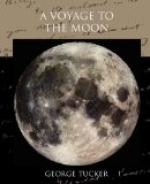and gradually the whole Mediterranean, and Arabian
Gulf—the great media separating Africa
from Europe and Asia; “the political divisions
of these quarters of the world were of course undistinguishable,
and few of the natural were discernible by the naked
eye. The Alps were marked by a white streak,
though less bright than the water.” By the
aid of the glass they could just discern the Danube,
the Nile, and “a river which empties itself
into the Gulf of Guinea,” and which Atterley
took to be the Niger; but the other streams were not
perceptible. The most conspicuous object of the
solid part of the globe was the great Desert; the
whole of Africa, however, appeared of a brighter hue
than either Asia or Europe.
“I was struck too, with the vast disproportion which the extent of the several countries of the earth bore to the part they had acted in history, and the influence they had exerted on human affairs. The British islands had diminished to a speck, and France was little larger, yet, a few years ago it seemed, at least to us in the United States, as if there were no other nations on the earth. The Brahmin, who was well read in European history, on my making a remark on this subject, reminded me that Athens and Sparta had once obtained almost equal celebrity, although they were so small as not now to be visible. As I slowly passed the telescope over the face of Europe, I pictured to myself the fat, plodding Hollander—the patient, contemplative German—the ingenious, sensual Italian—the temperate Swiss—the haughty, superstitious Spaniard—the sprightly, self-complacent Frenchman—the sullen and reflecting Englishman—who monopolise nearly all the science and literature of the earth, to which they bear so small a proportion. As the Atlantic fell under our view, two faint circles on each side of the equator, were to be perceived by the naked eye. They were less bright than the rest of the ocean. The Brahmin suggested that they might be currents; which brought to my memory Dr. Franklin’s conjecture on the subject, now completely verified by this circular line of vapour, as it had been previously rendered probable by the floating substances, which had been occasionally picked up, at great distances from the places where they had been thrown into the ocean. The circle was whiter and more distinct, where the Gulf Stream runs parallel to the American coast, and gradually grew fainter as it passed along the Banks of Newfoundland, to the coast of Europe, where, taking a southerly direction, the line of the circle was barely discernible. A similar circle of vapour, though less defined and complete, was perceived in the South Atlantic Ocean.”
By degrees the travellers saw one half of the broad expanse of the Pacific, which glistened like quicksilver or polished steel, and subsequently the middle of the Pacific lay immediately beneath them; the irregular distribution of land and water on the globe, the expanse




